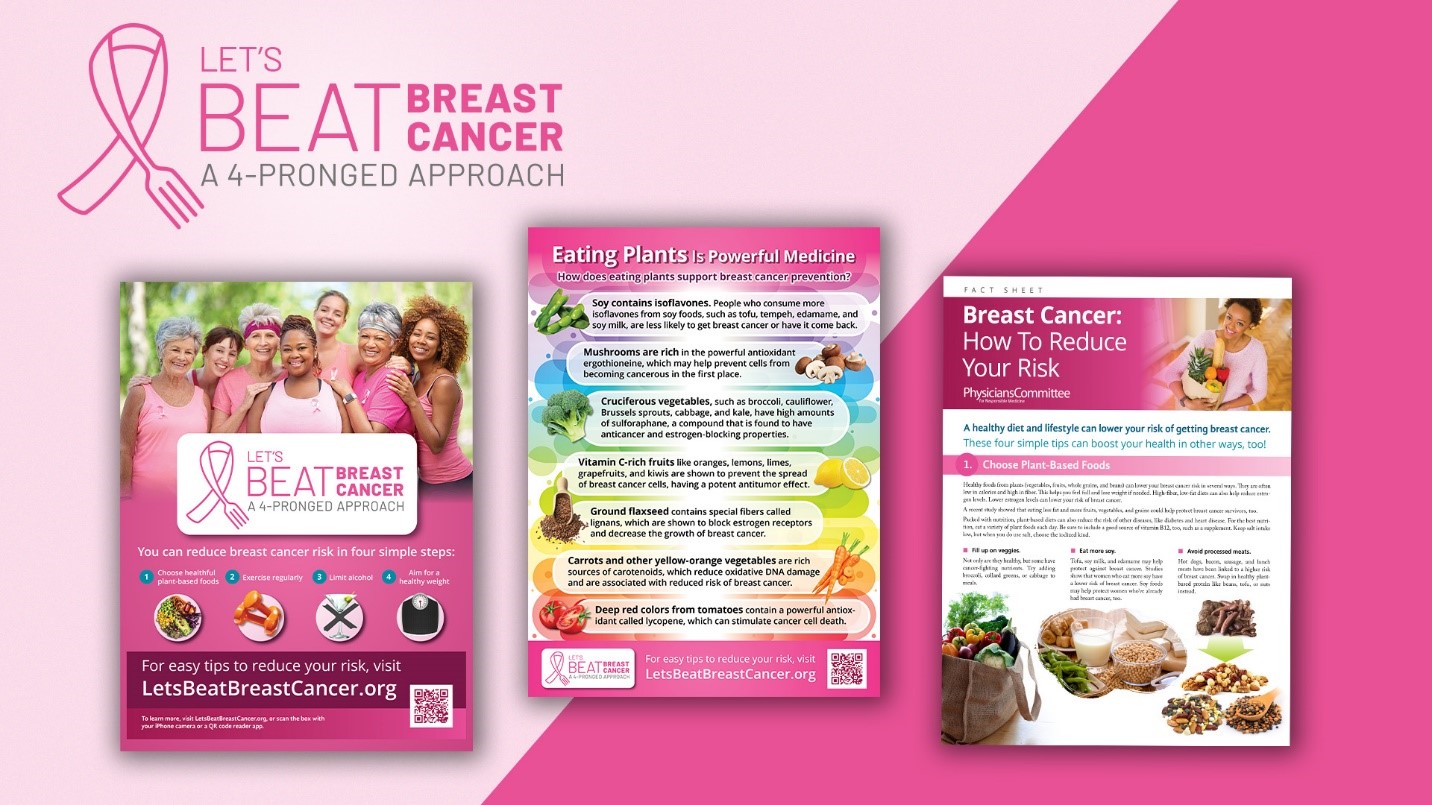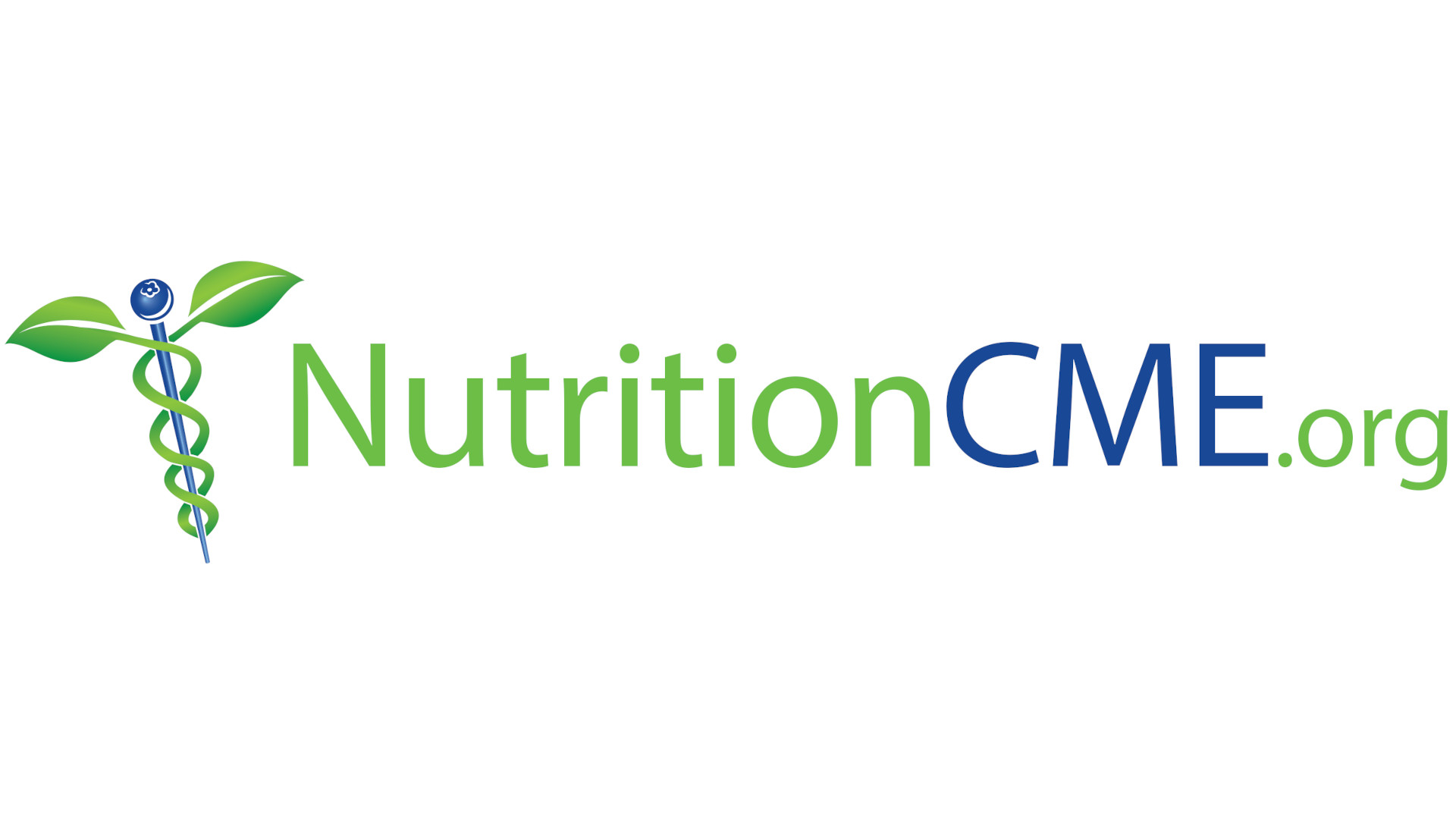Select a Section
Are you a healthcare provider interested in spreading the word about reducing breast cancer risk?
Join this esteemed list of health care providers who are spreading the word about reducing breast cancer risk!
Become a Partner in Prevention! Your name will be listed below and you'll receive free PDFs of our patient fact sheet and colorful waiting room poster.
Partners in Prevention
Scientific Support
A substantial body of research has shown that lifestyle factors contribute to the risk of developing breast cancer and influence outcomes after a breast cancer diagnosis. The following guidelines aim to put this knowledge to work, helping individuals to protect their health.
1. The more your diet is built from healthful plant-based foods, the lower your risk of getting breast cancer or having it come back.
Healthful foods from plant sources (vegetables, fruits, whole grains, and legumes) reduce breast cancer risk in several ways:
Easier weight control. Achieving a healthy body weight reduces the risk of postmenopausal breast cancer and reduces the likelihood of cancer recurrence. In observational studies, plant-based (vegan) diets are associated with healthier body weights, compared with diets including meat and/or dairy products. In the Oxford cohort of the European Prospective Investigation to Cancer and Nutrition (EPIC), the mean BMI among meat-eaters was 24.4 kg/m2 for men and 23.5 kg/m2 for women; among those avoiding animal products, the corresponding figures were 22.5 kg/m2 for men and 22.0 kg/m2 for women.1 In a U.S. cohort, the differences were more striking. In the Adventist Health Study-2, including 60,903 men and women 30 years of age and older, the mean BMI among meat-eaters was 28.8 kg/m2, compared with 23.6 kg/m2 for those avoiding meat, dairy products, and eggs.2 Similarly, clinical trials with overweight individuals have shown that plant-based foods predictably cause weight loss.3
Plant-based diets encourage healthful weight control in two ways. First, because foods from plant sources are generally high in fiber and low in fat, they have low energy density (fewer calories per gram of food). Second, low-fat vegan diets increase after-meal energy expenditure—an increased calorie “burn” after meals.4
Healthful hormone levels. Estrogens play critical roles in breast cancer initiation, promotion, and progression.5 Higher blood estradiol concentrations are associated with increased risk of postmenopausal breast cancer.6 In clinical trials, high-fiber, low-fat diets have been shown to reduce estradiol and estrone concentrations by roughly 10 to 25 percent,7,8,9 with a similar effect on urinary estrogens.10 In part, this may be due to weight loss. To the extent that high-fiber, low-fat diets reduce body fat, they may also reduce estrogen production. In addition, dietary fiber interrupts enterohepatic circulation of estrogens, so that they are excreted, rather than being allowed to circulate in the bloodstream.
Special cancer-fighting properties. Apart from their fiber content and low fat content, certain plants appear to be particularly beneficial for reducing cancer risk. This appears to be true for vegetables as a group. In the EPIC Italy study including more than 31,000 women with a median follow-up of 11 years, those in the highest quintile of vegetable consumption were 35% less likely to develop breast cancer, compared with the lowest quintile. Within this food group, green leafy vegetables (e.g., salad vegetables, chard, and spinach) emerged as particular contributors to the protective association.11 In the Pooling Project of Prospective Studies of Diet and Cancer, combining data from 20 cohort studies including 993,466 women with follow-up periods ranging from 11 to 20 years, women consuming the most vegetables had 18 percent lower risk of developing estrogen receptor negative breast cancer, compared with women consuming the least vegetables.12 The effect of vegetable consumption on other forms of breast cancer was less clear.13,14 The apparent benefit of vegetables may be due to their content of folate and other vitamins, the ability of cruciferous vegetables to induce phase 2 enzymes that assist in the removal of carcinogenic chemicals, or to other effects of natural phytochemicals in vegetables.
Soy products, and the isoflavones they contain, appear to reduce breast cancer risk. A 2013 meta-analysis included results from 22 prior studies. Among Asian women, high isoflavone consumption (compared with the lowest consumption) was associated with a 32 percent reduction in breast cancer risk; a protective effect was observed for both pre- and postmenopausal cancers.15 A 2014 meta-analysis reached similar conclusions.16 Among Western women, there is very little soy consumption, making comparisons between high and low consumption more difficult.
The use of soy products is also associated with reduced risk of recurrence and mortality among women previously diagnosed with breast cancer. The After Breast Cancer Pooling Project combined data from 9,514 breast cancer survivors from two U.S. cohorts and one Chinese cohort with a mean follow-up of 7.4 years. Cancer recurrence was 36% less common and cancer-specific mortality was 29% lower for those in the highest decile of isoflavone intake, compared with the lowest decile. Protective associations were evident for both estrogen receptor positive and estrogen receptor negative cancers.17 A meta-analysis of five studies including 11,206 women previously diagnosed with breast cancer with median follow-up ranging from 3.9 to 7.3 years found that those with the highest soy intake after diagnosis had a 26% reduced risk of recurrence and 16% reduced risk of mortality. Protective associations were found for both pre- and postmenopausal women and for both estrogen receptor positive and estrogen receptor negative cancers.18
Isoflavones may reduce estrogen biosynthesis and are under study for their antiproliferative, antioxidant, anti-angiogenesis, and anti-inflammatory properties.
It should be acknowledged that there is a widespread misunderstanding regarding soy’s effects on cancer risk, largely stemming from ambiguous results of animal and in vitro studies, which has been addressed by the human studies summarized in the meta-analyses cited above.
Healthful replacements for animal products. Consumption of certain animal products, such as red and processed meats (sausage, bacon, turkey bacon, ham, hot dogs, and deli slices),19,20,21 and eggs,22 is associated with breast cancer risk. For example, a 2018 meta-analysis of 15 studies showed that those with the highest (versus lowest) consumption of processed meats had a 9 percent higher risk of breast cancer.20 These products are easily replaced by plant-based alternatives.
Also, among women previously diagnosed with breast cancer, consumption of high-fat dairy products is associated with increased mortality risk. The Life After Cancer Epidemiology study included 1,893 women previously diagnosed with early-stage invasive breast cancer. After a median follow-up of 11.8 years, those consuming one or more servings of high-fat dairy products (e.g., cheese, ice cream, whole milk) daily had a 49 percent higher breast cancer mortality, compared with those consuming less than one-half serving daily.23 To the extent these products are replaced by plant-derived foods, risk is likely to be reduced.
The mechanistic links between animal products and breast cancer relate to their content of saturated fat;24 natural and synthetic estrogens;25 heme iron, which may encourage oxidative damage to DNA;26 nitrates and/or nitrites, which promote the formation of carcinogenic N-nitroso compounds;27 and carcinogenic polycyclic aromatic hydrocarbons and heterocyclic amines, which form when meat is cooked.28,29
2. Regular vigorous exercise reduces your risk.
Physical activity reduces the risk of postmenopausal breast cancer, and vigorous physical activity decreases the risk of both pre- and postmenopausal breast cancer. A meta-analysis done as part of the Continuous Update Project (CUP) of the World Cancer Research Fund and American Institute for Cancer Research combined the results of eight prior studies in postmenopausal women, finding that regular exercise was associated with a 13 percent lower risk of developing breast cancer.13 For vigorous exercise—for example, running or fast cycling—there is evidence of a reduction in risk for both pre- and postmenopausal breast cancer. In CUP meta-analyses of published studies, regular vigorous exercise was associated with a 17 percent reduction in breast cancer risk in premenopausal women and 10 percent reduction in postmenopausal women.13
Exercising women have lower levels of circulating estrogens, compared with sedentary women,30 although this benefit may be partly due to weight loss from exercise.31,32 Exercise can also strengthen immune defenses, which may help the body eliminate cancer cells that arise. Insulin resistance and high fasting insulin are linked to breast cancer risk; physical activity can improve these parameters.13,33
3. The less alcohol you consume, the lower your risk.
Alcohol consumption increases breast cancer risk.34 For premenopausal women, each glass of wine consumed per day increases the chances of developing breast cancer by about seven percent. Two glasses a day increase a woman’s risk by fourteen percent, and so on.13 The same is true for other alcoholic beverages. A bottle of beer, a five-ounce glass of wine, or a shot of liquor all have about the same alcohol content. For older women, the effect is amplified. For each drink a postmenopausal woman consumes daily, her risk of breast cancer increases by about thirteen percent.13
Alcohol’s effects may relate to its ability to increase sex hormone levels and contribute to DNA damage.35,36
4. The closer you are to a healthy weight, the lower your risk of breast cancer after menopause.
Excess body weight increases the odds of developing postmenopausal breast cancer.37 In the Nurses’ Health Study, heavier women (BMI above 30 kg/m2) were found to be 47 percent more likely to develop breast cancer, compared with those with a BMI under 23 kg/m2.38 This finding may relate to body fat’s ability to produce estrogens. In fat cells, the aromatase enzyme converts androstenedione and testosterone to estrone and estradiol, respectively.
Adiposity is also associated with increased circulating insulin and leptin and reduced plasma concentrations of sex hormone-binding globulin (a binding protein that keeps sex hormones inactive), all of which may play a role in breast cancer risk.39
It should be noted that, prior to menopause, women with extra body fat have a lower risk for breast cancer than thinner women. However, after menopause, breast cancer becomes far more common (80 percent of all breast cancer in the U.S. occurs in women over 50 years old),40 and overweight women are at a much greater risk. Excess body weight is also associated with a worse prognosis in women diagnosed with cancer.41 Carrying extra weight into mid-life is also linked to diabetes, hypertension, heart disease, and other health problems, so maintaining a healthy weight—that is, a body mass index (BMI) of 18.5-24.9 kg/m2–is beneficial at every age. Following the previous three steps—choosing plant-based foods, exercising regularly, and limiting alcohol—all facilitate attaining and maintaining a healthy weight.
References
- Spencer EA, Appleby PN, Davey GK, Key TJ. Diet and body mass index in 38,000 EPIC-Oxford meat-eaters, fish-eaters, vegetarians, and vegans. Int J Obesity. 2003;27:728-34.
- Tonstad S, Butler T, Yan R, Fraser GE. Type of vegetarian diet, body weight, and prevalence of type 2 diabetes. Diabetes Care. 2009;32:791-6.
- Barnard ND, Levin SM, Yokoyama Y. A systematic review and meta-analysis of changes in body weight in clinical trials of vegetarian diets. J Acad Nutr Diet. 2015 Jun;115(6):954-69.
- Barnard ND, Scialli AR, Turner-McGrievy G, Lanou AJ, Glass J. The effects of a low-fat, plant-based dietary intervention on body weight, metabolism, and insulin sensitivity. Am J Med. 2005;118:991-997.
- Yager JD, Davidson NE. Estrogen carcinogenesis in breast cancer. N Engl J Med. 2006;354:270-82.
- Endogenous Hormones and Breast Cancer Collaborative Group (EHBCCG). Endogenous sex hormones and breast cancer in postmenopausal women: reanalysis of nine prospective studies. J Natl Cancer Inst. 2002;94:606-16.
- Rose DP, Goldman M, Connolly JM, Strong LE. High-fiber diet reduces serum estrogen concentrations in premenopausal women. Am J Clin Nutr. 1991;54:520–5.
- Goldin BR, Woods MN, Spiegelman DL, et al. The effect of dietary fat and fiber on serum estrogen concentrations in premenopausal women under controlled dietary conditions. Cancer. 1994;74(3 Suppl):1125-31.
- Bagga D, Ashley JM, Geffrey SP, et al. Effects of a very low fat, high fiber diet on serum hormones and menstrual function. Implications for breast cancer prevention. Cancer. 1995;76(12):2491-6.
- Carruba G, Granata OM, Pala V, Campisi I, Agostara B, Cusimano R, et al. A traditional Mediterranean diet decreases endogenous estrogens in healthy postmenopausal women. Nutr Cancer. 2006;56:253-9.
- Masala G, Assedi M, Bendinelli B, et al. Fruit and vegetables consumption and breast cancer risk: the EPIC Italy study. Breast Cancer Res Treat. 2012;132(3):1127–36.
- Jung S, Spiegelman D, Baglietto L, et al. Fruit and vegetable intake and risk of breast cancer by hormone receptor status. J Natl Cancer Inst. 2013;105(3):219-36.
- World Cancer Research Fund/American Institute for Cancer Research. Continuous Update Project Expert Report 2018. Diet, Nutrition, Physical Activity and Breast Cancer. Available at dietandcancerreport.org.
- Emaus MJ, Peeters PH, Bakker MF, et al. Vegetable and fruit consumption and the risk of hormone receptor-defined breast cancer in the EPIC cohort. Am J Clin Nutr. 2016;103:168-77.
- Xie Q, Chen ML, Qin Y, et al. Isoflavone consumption and risk of breast cancer: a dose-response meta-analysis of observational studies. Asia Pac J Clin Nutr. 2013;22(1):118-27.
- Chen M, Rao Y, Zheng Y, et al. Association between soy isoflavone intake and breast cancer risk for pre- and post-menopausal women: a meta-analysis of epidemiological studies. PLoS ONE. 2014;9(2):e89288.
- Nechuta SJ, Caan BJ, Chen WY, et al. Soy food intake after diagnosis of breast cancer and survival: an in-depth analysis of combined evidence from cohort studies of US and Chinese women. Am J Clin Nutr. 2012;96:123-32.
- Chi F, Wu R, Zeng YC, Xing R, Liu Y, Xu ZG. Post-diagnosis soy food intake and breast cancer survival: A meta-analysis of cohort studies. Asian Pac J Cancer Prev. 2013;14(4):2407-2412.
- Farvid MS, Cho E, Chen WY, Eliassen AH, Willett WC. Dietary protein sources in early adulthood and breast cancer incidence: prospective cohort study. BMJ. 2014;348:g3437.
- Farvid MS, Stern MC, Norat T, et al. Consumption of red and processed meat and breast cancer incidence: a systematic review and meta-analysis of prospective studies. Int J Cancer. 2018;143(11):2787-99.
- Inoue-Choi M, Sinha R, Gierach GL, Ward MH. Red and processed meat, nitrite, and heme iron intakes and postmenopausal breast cancer risk in the NIH-AARP Diet and Health Study. Int J Cancer. 2016;138:1609-18.
- Keum N, Lee DH, Marchand N, et al. Egg intake and cancers of the breast, ovary and prostate: a dose-response meta-analysis of prospective observational studies. Br J Nutr. 2015;114:1099-107.
- Kroenke CH, Kwan ML, Sweeney C, Castillo A, Caan BJ. High- and low-fat dairy intake, recurrence, and mortality after breast cancer diagnosis. J Natl Cancer Inst. 2013;105:616–23.
- Brennan SF, Woodside JV, Lunny PM, Cardwell CR, Cantwell MM. Dietary fat and breast cancer mortality: A systematic review and meta-analysis. Crit Rev Food Sci Nutr. 2017;57:1999-2008.
- Leffers H, Naesby M, Vendelbo B, Skakkebaek NE, Jørgensen M. Oestrogenic potencies of Zeranol, oestradiol, diethylstilboestrol, Bisphenol-A and genistein: implications for exposure assessment of potential endocrine disrupters. Hum Reprod. 2001;16(5):1037–45.
- Inoue-Choi M, Sinha R, Gierach GL, Ward MH. Red and processed meat, nitrite, and heme iron intakes and postmenopausal breast cancer risk in the NIH-AARP Diet and Health Study. Int J Cancer. 2016;138:1609-18.
- Taylor EF, Burley VJ, Greenwood DC, Cade JE. Meat consumption and risk of breast cancer in the UK Women’s Cohort Study. Br J Cancer. 2007;96(7):1139-46.
- Zheng W, Gustafson DR, Sinha R, et al. Well-done meat intake and the risk of breast cancer. J Natl Cancer Inst. 1998;90:1724-1729.
- Zheng W, Lee SA. Well-done meat intake, heterocyclic amine exposure, and cancer risk. Nutr Cancer. 2009;61:437-46.
- McTiernan A, Wu L, Chen C, et al. Relation of BMI and physical activity to sex hormones in postmenopausal women. Obesity. 2006;14:1662-77.
- McTiernan A, Tworoger SS, Ulrich CM, et al. Effect of exercise on serum estrogen in postmenopausal women: a 12-month randomized clinical trial. Cancer Res. 2004;64:2923–8.
- McTiernan A, Tworoger S, Rajan B, et al. Effect of exercise on serum androgens in postmenopausal women: a 12-month randomized clinical trial. Cancer Epidemiol Biomarkers Prev. 2004b;13:1–7.
- Meneses-Echávez JF, Correa-Bautista JE, Gonzalez-Jimenez E, et al. The effect of exercise training on mediators of inflammation in breast cancer survivors: a systematic review with meta-analysis. Cancer Epidemiol, Biomarkers Prev. 2016;25(7):1009–17.
- Chen WY, Rosner B, Hankinson SE, Colditz GA, Willett WC. Moderate alcohol consumption during adult life, drinking patterns, and breast cancer risk. JAMA. 2011;306(17):1884-90.
- Hirko KA, Spiegelman D, Willett WC, Hankinson SE, Eliassen AH. Alcohol consumption in relation to plasma sex hormones, prolactin, and sex hormone-binding globulin in premenopausal women. Cancer Epidemiol Biomarkers Prev. 2014;23(12):2943-53.
- Singletary KW, Gapstur SM. Alcohol and breast cancer: review of epidemiologic and experimental evidence and potential mechanisms. JAMA. 2001;286:2143-51.
- Chlebowski RT, Luo J, Anderson GL, et al. Weight loss and breast cancer incidence in postmenopausal women. Cancer. 2019;125(2):205-212.
- Zhang X, Eliassen AH, Tamimi RM, et al. Adult body size and physical activity in relation to risk of breast cancer according to tumor androgen receptor status. Cancer Epidemiol Biomarkers Prev. 2015;24(6):962-8.
- Kendall A, Folkerd EJ, Dowsett M. Influences on circulating oestrogens in postmenopausal women: relationship with breast cancer. J Steroid Biochem Molecular Biology. 2007;103(2):99–109.
- American Cancer Society, Breast Cancer Facts & Figures 2017–2018 (2017), accessed January 25, 2019, https://www.cancer.org/content/dam/cancer-org/research /cancer-facts-and-statistics/breast-cancer-facts-and-f igures/breast-cancer-facts-and -f igures-2017-2018.pdf.
- Rock CL, Demark-Wahnefried W. Nutrition and survival after the diagnosis of breast cancer: a review of the evidence. J Clin Oncol. 2002;20:3302-3316.









